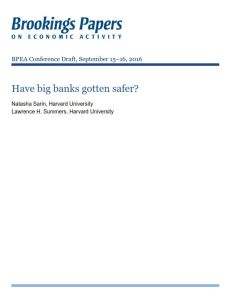Únase a getAbstract para acceder al resumen.

Únase a getAbstract para acceder al resumen.
Natasha Sarin and Lawrence H. Summers
Have Big Banks Gotten Safer?
Brookings Institution, 2016
¿De qué se trata?
More rules and regulations may not have reduced the risk of large banks failing.
Recommendation
In response to the 2008 financial crisis, policy officials around the globe crafted a vast new regulatory architecture to decrease the risk of large financial institutions failing and thus prevent future systemic shocks to the economy. Economists Lawrence H. Summers and Natasha Sarin assess the outcome of these efforts. They argue that the safety of the world’s biggest financial organizations may not be as robust as government leaders believe. getAbstract recommends their rigorous and discerning report to policy makers and financial professionals.
Summary
About the Authors
Natasha Sarin is a PhD candidate at Harvard University, where Lawrence H. Summers is president emeritus and a professor of economics.




















Comment on this summary